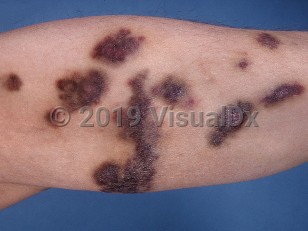AIDS-associated Kaposi sarcoma - Anogenital in
See also in: Overview,External and Internal Eye,Oral Mucosal LesionAlerts and Notices
Important News & Links
Synopsis

Kaposi sarcoma (KS) is a malignant neoplasm of lymphatic endothelial cell origin that occurs in several forms: AIDS-associated and non-AIDS-associated. Subtypes of non-AIDS-associated KS include classic KS, African endemic KS, and iatrogenic KS. All types of KS are due to or influenced by human herpesvirus type 8 (HHV-8), and cutaneous findings are clinically and histologically indistinguishable among the types.
The outbreak of KS among young, previously healthy men who have sex with men (MSM) heralded the recognition of AIDS in 1981. AIDS-associated KS is the most common neoplasm in human immunodeficiency virus (HIV)-seropositive patients and is an AIDS-defining illness. This form of KS is primarily seen in the MSM population. Lesions may worsen during immune reconstitution inflammatory syndrome and may also appear in patients with HIV who have received long-term antiretroviral therapy (ART).
Lesions on the penis are common, and, in rare cases, the lesions may invade and penetrate the periurethral tissue, affecting urinary flow. The lesions are asymptomatic; however, large lesions may become eroded, cause pain, and form chronic ulcers.
The introduction of ART dramatically decreased the incidence, morbidity, and mortality of AIDS-associated KS. ART should be considered first-line treatment for AIDS-associated KS.
The outbreak of KS among young, previously healthy men who have sex with men (MSM) heralded the recognition of AIDS in 1981. AIDS-associated KS is the most common neoplasm in human immunodeficiency virus (HIV)-seropositive patients and is an AIDS-defining illness. This form of KS is primarily seen in the MSM population. Lesions may worsen during immune reconstitution inflammatory syndrome and may also appear in patients with HIV who have received long-term antiretroviral therapy (ART).
Lesions on the penis are common, and, in rare cases, the lesions may invade and penetrate the periurethral tissue, affecting urinary flow. The lesions are asymptomatic; however, large lesions may become eroded, cause pain, and form chronic ulcers.
The introduction of ART dramatically decreased the incidence, morbidity, and mortality of AIDS-associated KS. ART should be considered first-line treatment for AIDS-associated KS.
Codes
ICD10CM:
C46.9 – Kaposi's sarcoma, unspecified
SNOMEDCT:
420524008 – Kaposi's sarcoma associated with AIDS
C46.9 – Kaposi's sarcoma, unspecified
SNOMEDCT:
420524008 – Kaposi's sarcoma associated with AIDS
Look For
Subscription Required
Diagnostic Pearls
Subscription Required
Differential Diagnosis & Pitfalls

To perform a comparison, select diagnoses from the classic differential
Subscription Required
Best Tests
Subscription Required
Management Pearls
Subscription Required
Therapy
Subscription Required
References
Subscription Required
Last Reviewed:01/01/2024
Last Updated:02/08/2024
Last Updated:02/08/2024
AIDS-associated Kaposi sarcoma - Anogenital in
See also in: Overview,External and Internal Eye,Oral Mucosal Lesion

